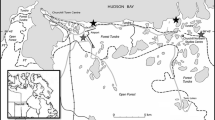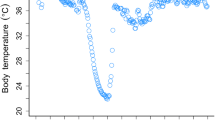Summary
The daily energy requirements of swallow Hirundo rustica and sand martin Riparia riparia adults with broods of different sizes were compared with the energy (food) gain rates of adults. Energy requirements of broods were obtained from food delivery rates, growth rates and from published data. The energy requirements of adults were obtained from D2O18 measurements and from time budgets. Energy gain rates were measured from food delivery rates to collared nestlings. These energy gain rates were reduced in bad weather when food abundance was low. In good weather, energy gain rates were theoretically high enough to supply the energy needs of larger than normal broods. In bad weather, however, the adults would only be able to collect sufficient energy for a normal brood of four to six. I suggest that this effect of weather and feeding conditions on energy gain rates and, hence, on reproductive effort is an important factor in limiting the upper level of brood size in these species.
Similar content being viewed by others
References
Adams LEG (1957) Nest records of the Swallow. Bird Study 4:28–33
Barrentine CD (1980) The ingestion of grit by nestling barn swallows. J Field Orn 51:368–370
Bryant DM (1973) The factors influencing the selection of food by the house martin, Delichon urbica. J Anim Ecol 42:539–564
Bryant DM (1975) Breeding biology of the House Martin Delichon urbica in relation to aerial insect abundance. Ibis 117:180–215
Bryant DM (1978) Environmental influences on growth and survival of nestling House Martins Delichon urbica. Ibis 120:271–283
Bryant DM (1979) Reproductive costs in the house martin, Delichon urbica. J Anim Ecol 48:655–676
Bryant DM, Gardiner A (1979) Energetics of growth in house martins, Delichon urbica. J Zool Lond 189:275–304
Bryant DM, Turner AK (1982) Central place foraging by swallows (Hirundinidae): the question of load size. Anim Behav 30:845–856
Bryant DM, Westerterp KR (1980) The energy budget of the House Martin, Delichon urbica. Ardea 68:91–102
Bryant DM, Westerterp KR (1983) Time and energy limits to brood size in house martins (Delichon urbica). J Anim Ecol (in press)
Charnov EL, Krebs JR (1974) On clutch size and fitness. Ibis 116:217–219
De Steven D (1980) Clutch size, breeding success and parental survival in the Tree Swallow (Iridoprocne bicolor). Evolution 34:278–291
Dolnik VR, Gavrilov VM (1979) Bioenergetics of molt in the Chaffinch. Auk 96:253–264
Dolnik VR, Kinshevskaya LI (1980) Time and energy budgets during the nest period in the swift, Apus apus, and swallows, Delichon urbica and Hirundo rustica. Zool Zhurnal 59:1841–1851
Dowgiallo A (1968) Chemical composition of an animal's body and of its food. In: W Grodzinski, RZ Klekovski and A Duncan (eds), Methods for Ecological Bioenergetics. Blackwell, Oxford, IBP 24 pp 160–184
Dunn EH (1979) Time-energy use and life history strategies of northern seabirds. U.S. Dept Int Fish and Wildl 11:141–166
Dunn EH (1980) On the variability in energy allocation of nestling birds. Auk 97:19–27
Ettinger AD, King JR (1980) Time and energy budgets of the willow flycatcher (Empidonax trailii) during the breeding season. Auk 97:533–546
Fretwell S (1969) The adjustment of birthrate to mortality in birds. Ibis 111:624–626
Gadgil M, Bossert WH (1970) Life history consequences of natural selection. Am Nat 104:1–24
Greenstone MH (1979) Spider feeding behaviour optimises dietary essential amino-acid composition. Nature 282:501–503
Hails CJ (1979) A comparison of flight energetics in hirundines and other birds. Comp Biochem Physiol 63A:581–585
Hails CJ, Bryant DM (1979) Reproductive energetics of a freeliving bird. J Anim Ecol 48:471–482
Hazelwood RL (1965) Carbohydrate metabolism. In: PD Sturkie (ed), Avian Physiology, Cornell University Press, New York, pp 313–371
Kendeigh SC, Dolnik VR, Gavrilov VM (1977) Avian Energetics. In: Pinowski J, Kendeigh SC (eds), Granivorous Birds in Ecosystems, Cambridge University Press, pp 127–203
Keskpaik J (1968) Heat production and heat loss of swallows and martins during flight. Eesti NSU Teaduste Adadeemia Tolm XVII KOD 2:179–190
Klomp H (1970) The determination of clutch size in birds. Ardea 58:1–124
Lack D (1947) The significance of clutch size. Ibis 89:302–352
Lack D (1954) The Natural Regulation of Animal Numbers. Clarendon Press, Oxford
Long C (ed) (1968) The Biochemists' Handbook. E & FR Spon Ltd, London
Lyuleeva DS (1970) Energy of flight in swallows and swifts. Doklady Akad Nauk SSR 190:1467–1469
Martin EW (1968) The effects of dietary protein on the energy and nitrogen balance of the Tree Sparrow, Spizella a. arborea. Physiol Zool 41:313–331
Mason EA (1953) Barn Swallow life history data based on banding records. Bird-Banding 24:91–100
Morgan RA (1979) Sand Martin nest record cards. Bird Study 26:129–132
Morton ES (1973) On the evolutionary advantages and disadvantages of fruit cating in tropical birds. Am Nat 107:8–22
Nelson JB (1964) Factors influencing clutch size and chick growth in the North Atlantic Gannet Sula bassana. Ibis 106:63–77
O'Connor RJ (1975) The influence of brood size on metabolic rate and body temperature in nestling Blue Tits Parus caeruleus and House Sparrows Passer domesticus. J Zool Lond 175:391–403
O'Connor RJ (1976) Weight and body composition in nestling Blue Tits Parus caeruleus. Ibis 118:108–112
O'Connor RJ (1978) Growth strategies in nestling passerines. Living Bird 209–238
Rheinwald G (1971) Gewichtsentwicklung nestjunger Mehlschwalben bei verschiedenen Witterungsbedingungen. Charadrius 7:1–7
Ricklefs RE (1965) Brood reduction in the Curve-billed Thrasher. Condor 67:505–515
Snapp BD (1973) The occurrence of colonial breeding in the Barn Swallow, Hirundo rustica, and its adaptive significance. Unpubl doctoral thesis Cornell University, New York
Stoner D (1936) Studies of the Bank Swallow, Riparia riparia, in the Oneida Lake Region. Roosevelt Wildl Annals 4:126–233
Taylor LR, Palmer MP (1972) Aerial sampling. In: HF van Emden (ed), Aphid Technology, Academic Press, London pp 189–234
Turner AK (1980) The use of time and energy by aerial-feeding birds. Unpubl Ph.D. thesis, University of Stirling, UK
Turner AK (1982a) Timing of laying by swallows (Hirundo rustica) and sand martins (Riparia riparia). J Anim Ecol 51:29–46
Turner AK (1982b) Optimal foraging by the swallow (Hirundo rustica L.): prey size selection. Anim Behav 30:862–872
Waugh DR (1978) Predation strategies in aerial-feeding birds. Unpubl Ph.D. thesis, University of Stirling, UK
Westerterp KR (1973) The energy budget of the nestling Starling, Sturnus vulgaris, a field study. Ardea 61:137–158
Williams GC (1966) Natural selection, the costs of reproduction and a refinement of Lack's principle. Am Nat 106:687–690
Wilson EO (1975) Sociobiology: The New Synthesis. Harvard University Press
Yom-Tov Y, Hilborn R (1981) Energetic constraints on clutch size and timing of breeding in temperate zone birds. Oecologia (Berlin) 48:234–243
Author information
Authors and Affiliations
Rights and permissions
About this article
Cite this article
Turner, A.K. Time and energy constraints on the brood size of swallows, Hirundo rustica, and sand martins, Riparia riparia . Oecologia 59, 331–338 (1983). https://doi.org/10.1007/BF00378858
Received:
Issue Date:
DOI: https://doi.org/10.1007/BF00378858




